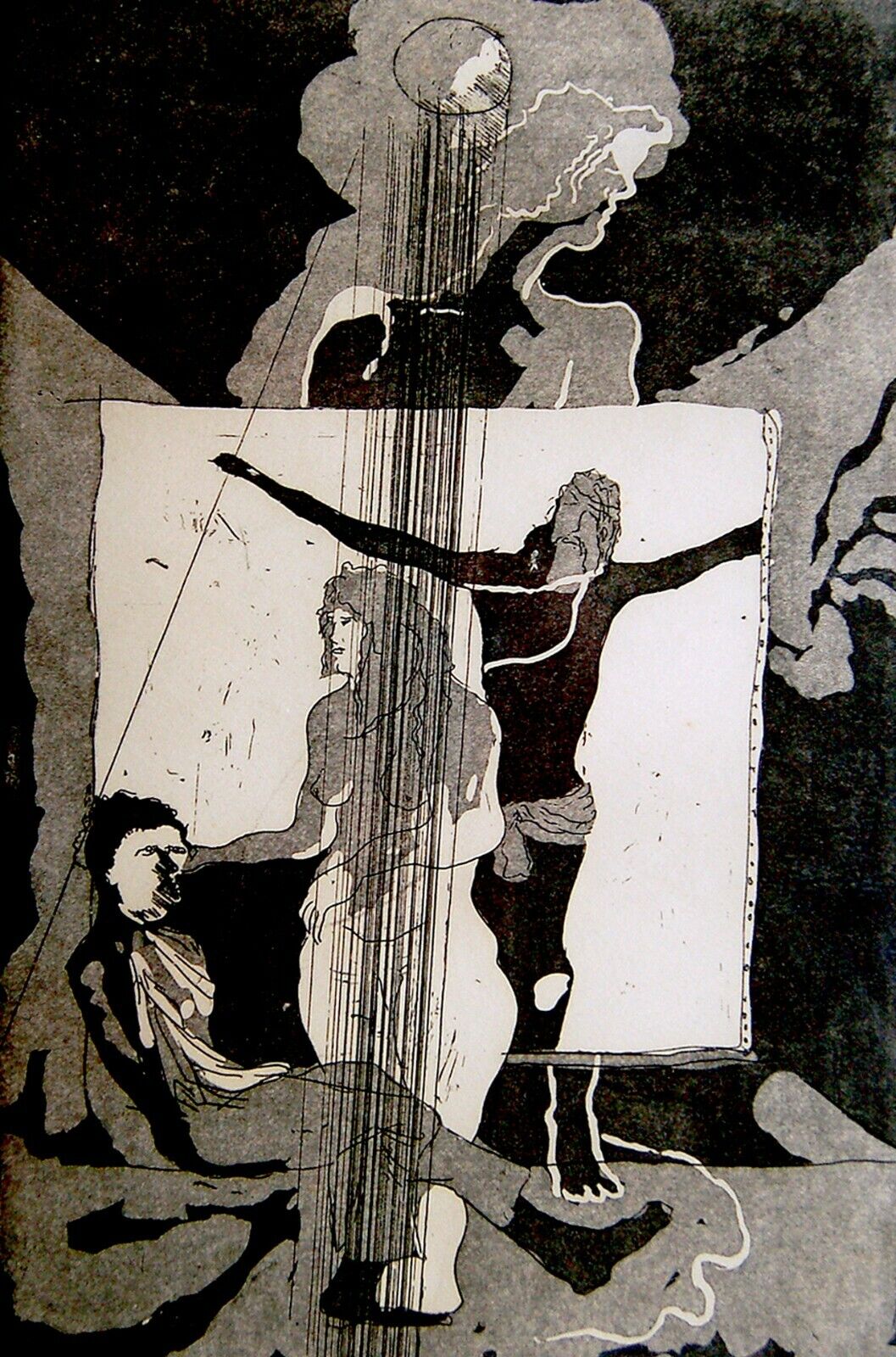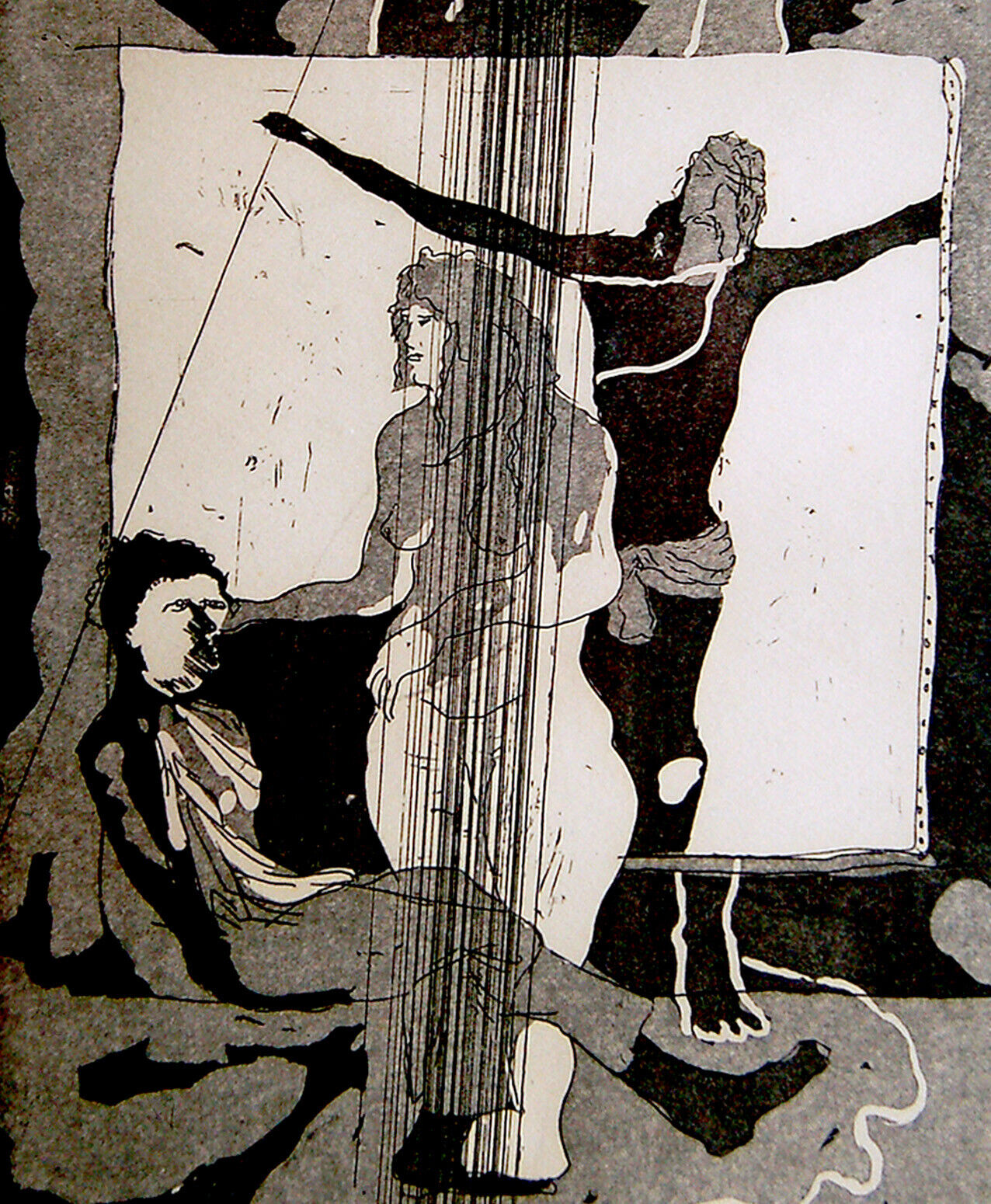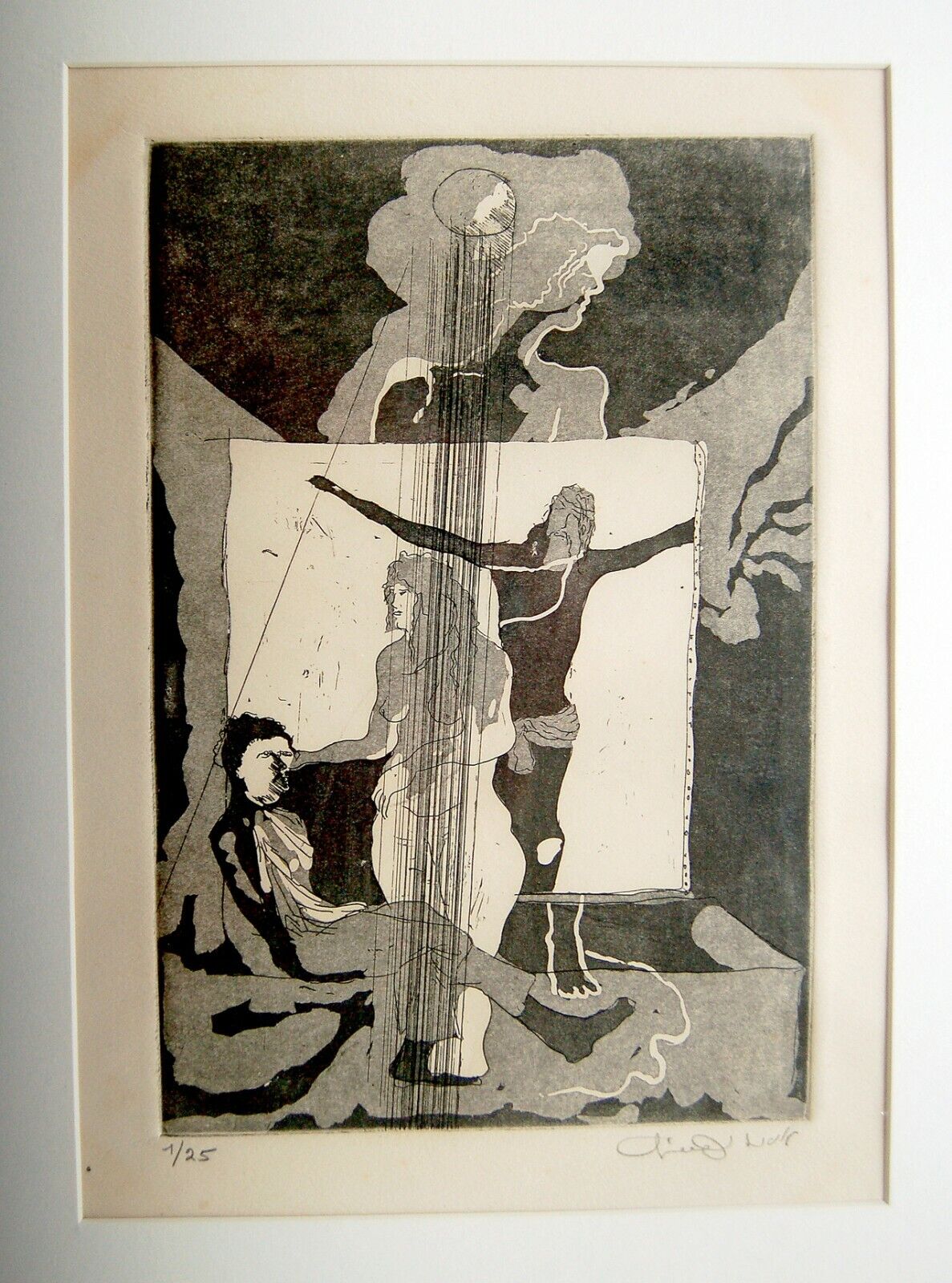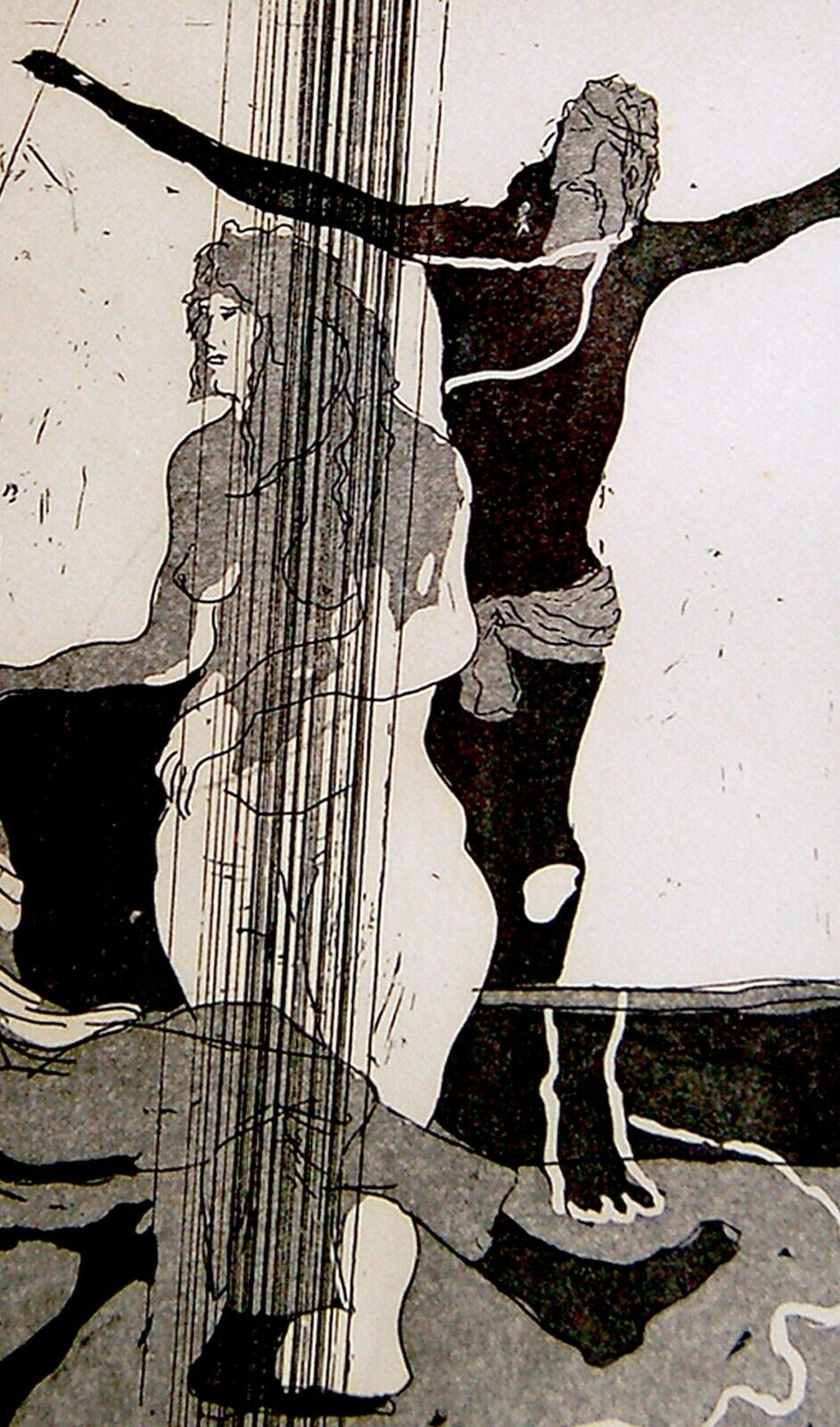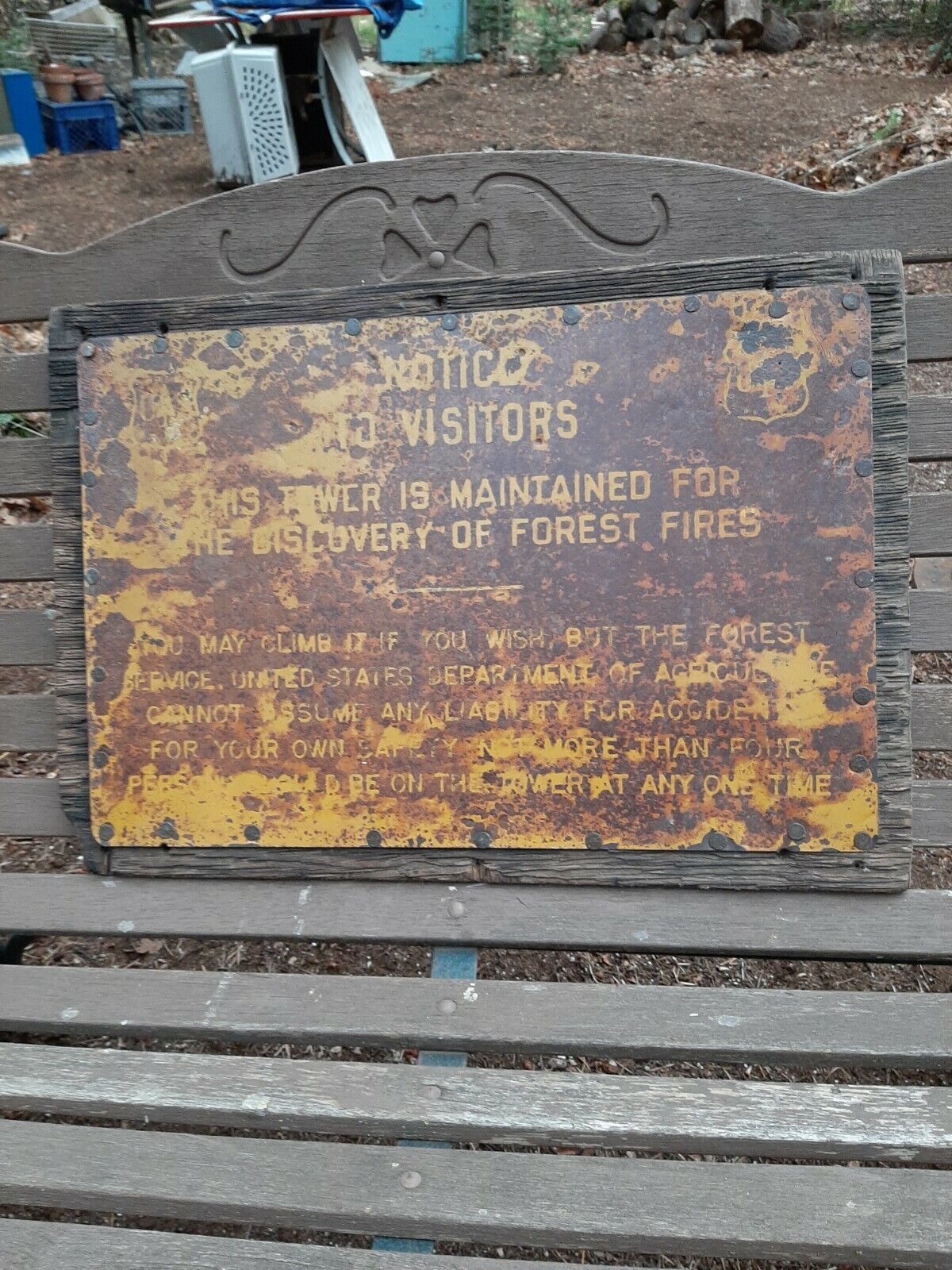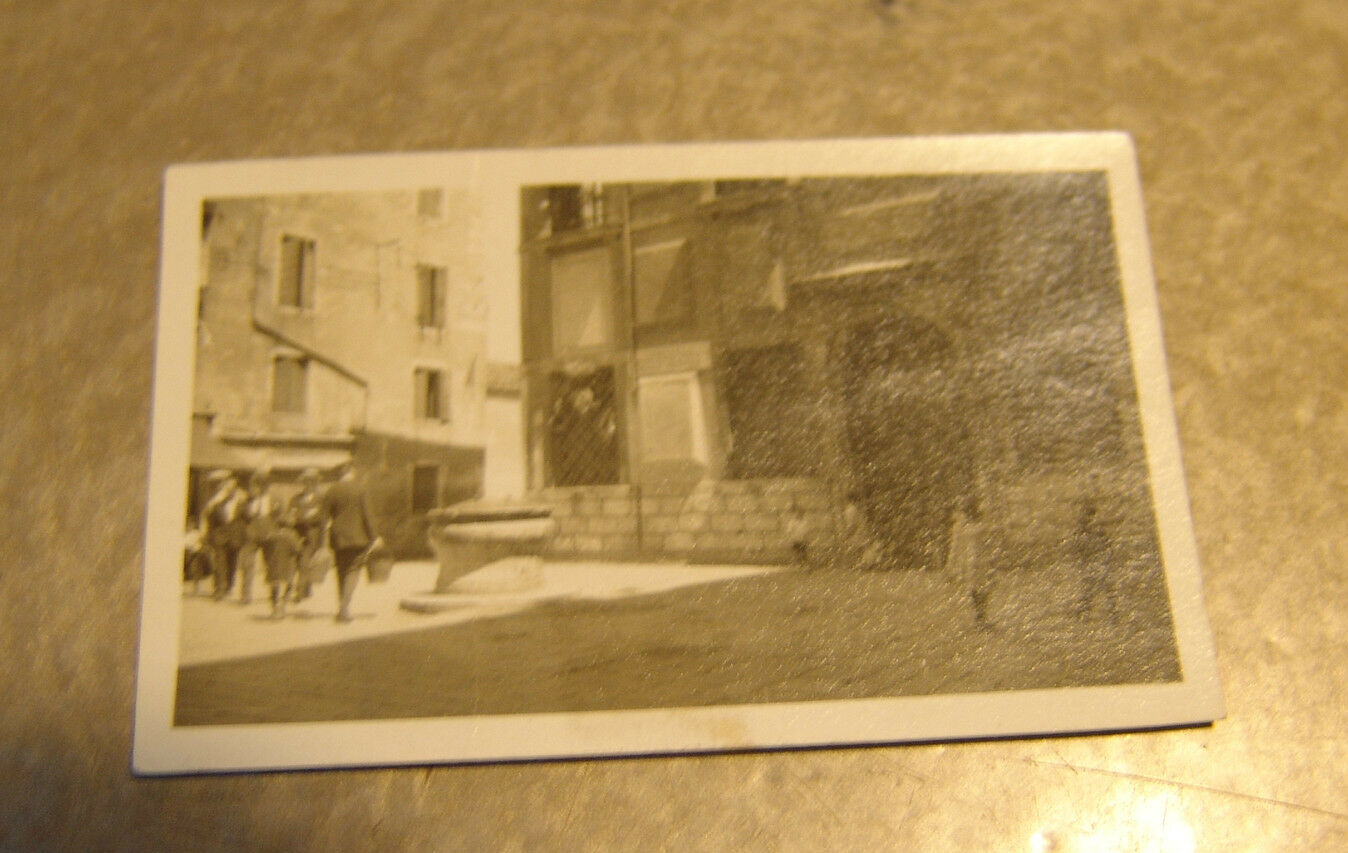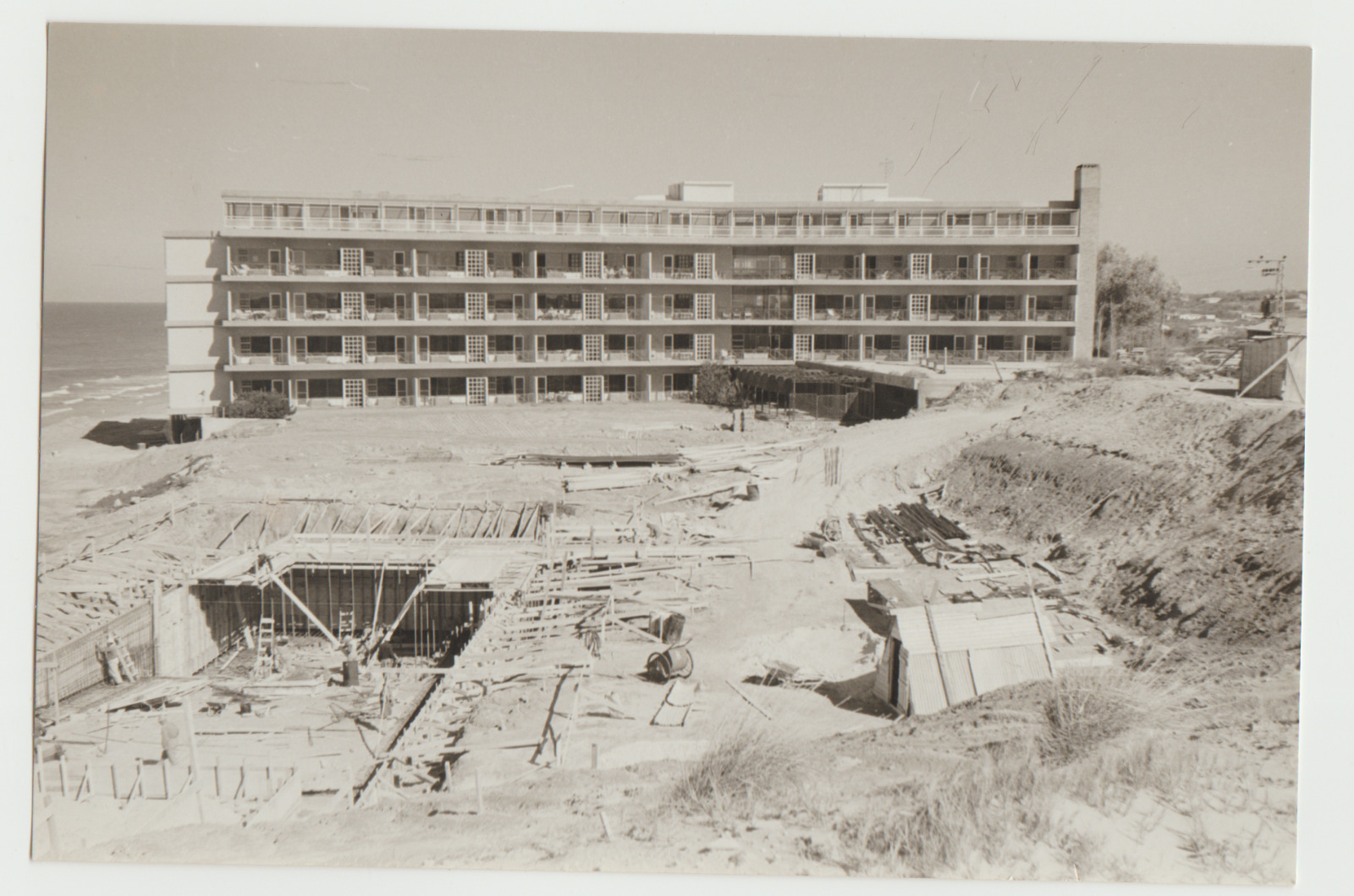-40%
Jewish URI LIFSHITZ Israel HAND SIGNED ART ETCHING Hebrew 1/25 Erotica + MAT
$ 66
- Description
- Size Guide
Description
DESCRIPTION:
Here for sale is an ORIGINAL ETCHING , Being the FIRST ONE in a VERY SMALL LIMITED EDITION of only 25 COPIES which is
hand SIGNED with pencil and numbered 1/25 by
the acclaimed Israeli artist , The painter and sculptor URI LIFSHITZ ( Also LIFSHIZ ) . Very boldly depicting a few FIGURATIVE figures in a somewhat EROTIC ATMOSPHERE
.
The whole scene is very REALISTIC , very impressive and full of movement. HAND SIGNED with PENCIL by the painter
1/25
.The etching is already MATTED - MOUNTED , Ready for immediate
framing . The MAT is quite thick and made of stiff cardboard. Size of the actual ETCHING is around 8" x 9" with around 1" perimeter margins. The size of the MAT-MOUNT is around 20" x 16" .
Excellent pristine condition.
( Pls look at scan for accurate AS IS images )
. W
ill be sent in a special protective rigid sealed packaging.
AUTHENTICITY
: This is an ORIGINAL hand signed ETCHING , NOT a reproduction or a reprint , It holds life long GUARANTEE for its AUTHENTICITY and ORIGINALITY.
PAYMENTS
: P
ayment method accepted : Paypal
& All credit cards
.
SHIPPMENT
:
Shipp worldwide via registered airmail is $ 29 for the etching without the MAT. for the etching with the MAT. W
ill be sent in a special protective rigid sealed packaging.
Handling around 5-10 days after payment.
The acclaimed sculptor and painter Uri Lifshitz, 75, died yesterday at his home in Tel Aviv after a battle with cancer. Lifshitz, one of Israel's most prominent artists during the 1960s and '70s, exhibited very little in the past few years. His reclusive lifestyle and extreme political statements are thought to have kept both the Israel Prize and a comprehensive retrospective of his work beyond his reach. "No other Israeli artist was so central for so many years to artists, critics and the public," Yair Garbuz, former head of Hamidrasha, the art school of Beit Berl College, and a close friend of Lifshitz, told Haaretz yesterday. Garbuz said there was a time when Lifshitz, who had no formal training in art, gave up the recognition he deserved as a member of New Horizons, the groundbreaking lyrical abstract school of artists that also included Igael Tumarkin and Rafi Lavie, among others. "Later, when he wanted to return to that central place, he might not have been able to," Garbuz said. Lifshitz dismissed critics of his later works who called him a has-been. He was awarded the Tel Aviv Museum of Art's Kolb Prize in 1965, and received the Dizengoff Prize in 1985. Lifshitz lived and worked in a studio in Tel Aviv's Neve Tzedek neighborhood with his youngest son, the artist Nadav Lifshitz. Uri Lifshitz is survived by seven children from three marriages. He will be laid to rest today at Kibbutz Givat Hashlosha, where he was born. Uri Lifschitz (Hebrew: אורי ליפשיץ) (1936-2011) was an Israeli painter.[1] Uri Lifschitz was born on Kibbutz Givat HaShlosha. He served in the Israel Defense Force paratrooper Unit 101 under Ariel Sharon. He began painting in the 1950s. In the 1960s and 1970s he was one of the founders of the 10 Plus group which posed an alternative to the lyrical abstract style of the New Horizons movement.[2] Awards and recognition Lifschitz won the Eugen Kolb Prize from the Tel Aviv Museum of Art in 1965, the Erasmus Prize in 1966 and the Dizengoff Prize in 1985.[2] In a 2008 documentary about him, artist-sculptor Uri Lifshitz predicts on camera that he will be dead in three years' time. "Seventy-five is enough for me." It will soon be two years since he passed away - at that age. Filmmaker Nurit Kedar's latest effort focuses on Lifshitz, his art and the void he has left behind. Yuval Cohen's 2008 film on the subject of myths and memory in Lifshitz's work was called "Man at Work," but Kedar's new movie - which was produced for Channel 1 and premiered recently at the Tel Aviv Museum of Art, as part of the EPOS International Art Film festival - is simply titled "Uri Lifshitz." "That's me in the coffin," Lifshitz says, pointing at one of the paintings in his studio, in a scene appearing toward the end of Kedar's film. It is a dark and elongated canvas, one in a series of death-related paintings, dark and even brutal, which depict in extremis his own burial process. "Scary?" asks his niece Hila Regev-Chen, who shot that part of the film about six years ago. "Once you get used to it, it's great. It doesn't hurt. I don't feel it at all," he says. In the next scene in "Uri Lifshitz," we see his widow Dorit, who is seen seated in front of the camera, and in a manner characteristic neither of her nor of him, reveals an intimate memory from among his final moments. "I went up to him and asked him if he can feel me, if he can hear me. He said to me, 'You are the most beautiful today.' Those were his last words." Those are also the last words in Kedar's film, which closes with a photograph shot by artist Dror Karta from afar: Lifshitz, a week before he died, working on his final painting. Uri Lifshitz, born in 1936 on Kibbutz Givat Hashlosha, died on May 28, 2011. He was self-taught, and never completed art studies. In the army he served in the legendary paratrooper Unit 101 alongside the likes of Meir Har-Zion and Ariel Sharon, the unit's commander. He began to paint in the 1950s while he still lived on the kibbutz, and was very successful in terms of critical acclaim. In the '60s and '70s, he was among the founders of the "10 Plus" group, along with Raffi Lavie, Buky Schwartz, Siona Shimshi and others, who formulated an alternative to the lyrical abstract style of the New Horizons movement that had dominated local art up until that time. Over the years, Lifshitz had many exhibitions in Israel and abroad, and his works are also in major private and museum collections here. He won a Eugen Kolb Prize from the Tel Aviv Museum of Art (1965 ), an Erasmus Prize (1966 ) and the Dizengoff Prize (1985 ). His first solo show was held in Tel Aviv at the Ekked Gallery in 1961, while his first solo museum exhibition was at the Israel Museum in 1969, curated by Yona Fischer, followed a year later by a show at the Tel Aviv Museum of Art. In addition, his work was showcased, among other venues, at the Sao Paulo Biennial and the Whitechapel Gallery in London. In Israel he worked alternately with the Givon, Bineth and Gordon galleries. He is known for his expressive paintings, the use he made in his work of newspaper photos of Israeli reality - for example, in the series that dealt with the trial of Yigal Amir, Yitzhak Rabin's murderer; presidents; judges; the evils of the occupation - and more. He also created countless engravings and bronze sculptures. Kedar's film runs 70 minutes. It is not a narrative in the least; it does not chart the artist's life chronologically. It does not supply biographical and personal details other than ones that arise in conversations with Lifshitz, such as about his memories from the kibbutz, his relationships with his parents and with his daughter Yasmin, who died of cancer in her 30's. Both of his ex-wives, the children he had with them, and his brother and his sister are absent from the story, as are many art world figures who filled some sort of role or another in the artist's career. The film has no subtitles, not even the names of those interviewed in it. Young viewers may not recognize the writer Yoram Kaniuk, who was Lifshitz's close friend for years; retired Supreme Court Justice Meir Shamgar, who inspired an entire series of paintings; or the photographer Ziv Koren, who spent about a year with Lifshitz in 2002 working on "Stones and Flags," a collaborative project featuring Lifshitz paintings based on Koren's photos from the second intifada. The emphasis in the new film is therefore on his art and its creation - his drive, work processes and the works themselves. Hundreds of the latter are seen here in still photographs taken by the director, one after another, both from up close and from a distance. "Uri Lifshitz," which is accompanied by an original soundtrack composed by the musician Avi Balali, another friend of Lipschitz's, was largely shot in the artist's studio. Whether we are talking about materials the director photographed herself or those supplied by other people who also contributed to the film - among them Eyal Geffen, Eldad Ziv, Zvi Shissel, Eado Zuckerman - everything takes place within the walls of the studio. "That was the only thing that I knew I wanted," Kedar says. "I don't go outside the studio. Physically and metaphorically. This is his world. You want to know who Uri Lifshitz is, you encounter him in the studio." The return to the studio was not easy for those who were close to him - for Shamgar, Koren and Kaniuk, and certainly his immediate family: Dorit, 55, and the couple's son Nadav, 26, an artist who worked alongside his father during his final years. "It took us a really long time to go back there. It was really hard," Dorit Lifshitz says in a recent interview with Haaretz. "Over the years I was in the studio a lot. We were in a tight and close-knit relationship, I was always involved. Uri involved me in everything. And coming to the studio when he's gone was a huge crisis." 'Outside the discourse' Lifshitz's studio is on the corner of Eilat and Abarbanel streets in south Tel Aviv, a short distance from the family home in the Neve Tzedek neighborhood. The studio actually takes up an entire three-story building, which the artist and his wife bought more than 20 years ago. The first floor is where most of Lifshitz's sculptures are stored , the second one holds unframed works such as collages, paintings, drawings and etchings, and the third and largest floor contains a spacious work area that also houses large oil paintings. Last year several groups of visitors came to the studio to learn about Lifshitz's work, his widow says. The family hopes to open the studio to the public someday. "When we tidied up the premises, we went through every piece of paper," Dorit Lifshitz explains. "He was very orderly, but wasn't really into documentation, and over the years we went along with him; he thought it was a waste of time. I think he was mistaken. We spread everything in the studio out before Nurit: the early works, the ambience he created in the studio throughout the years. She sensed it, too. To sit in the studio is not like sitting outdoors. You could practically smell him, hear the music he listened to there," she adds. Kedar's decision to film in the studio was made the first time she visited there. She had approached Lifshitz at a social event a year before he died, and told him she would like to make a documentary about him. A few days later she arrived at the studio with a small camcorder. "I walked in and I was in shock," Kedar recalls. "The amount of work. I go up three stories and there are more and more of them. You've never seen anything like it. I remember asking him how many paintings he had, and he said 2,400. I didn't believe it. I didn't understand. I mean, here is a man who received awards and exhibited plenty. And then I understood that something had happened [in his final decades]: He had disappeared." Infinite. I have 700 engravings. Rembrandt had 500." Lifshitz himself says in the movie: "Since 1970 I have not had a show at the two museums [at the Israel Museum and Tel Aviv Museum]. There was one show in '69, one in '70." Kedar asks if that pains him, and he replies that it does: It hurts that the works are not being seen. "Obviously everyone wants to get feedback," his widow explains. The only name from the local art world that is mentioned in the film is that of the late Prof. Mordechai Omer, the longtime director of the Tel Aviv Museum, who she says scheduled three meetings with Lifshitz and did not show up for a single one. "Uri - and I will say this as clearly as possible - was outside the discourse," she continues. "That is a fact. A lot of that was his doing. Uri was the most candid man I know. Sometimes this was to his benefit and sometimes not. Aside from the social sensitivity that guided the work itself, one of the things he insisted on was to be free. He didn't do so from a desire to be blunt, but because of the desire for creative freedom." What do you mean? "Uri, fully consciously or with complete lack of awareness, removed himself from every framework that he thought would not allow him the freedom of work that he needed. And I'm not talking only about artistic work and frameworks; we are also talking about social and familial frameworks. To leave a family with children twice is not an easy matter. Fortunately for me, we had a framework in which he remained for many years. It isn't always easy living alongside a man like that, and I'm not complaining for a moment. But for it all to last so many years, and with the way that we loved each other, like on the first day we met - that is something." Do you think he received the recognition he deserved? "He didn't get into that. He really didn't deal with that. The values of success customary in Israeli society and in the local art field were not valid in Uri's eyes, and did not interest him. Uri did not seek connections, nor was he afraid to place pieces everywhere. To the contrary, there was always criticism of where he chose to exhibit. The last exhibition he had at a highly regarded gallery was in the '80s at Gordon Gallery." When Lifshitz left the kibbutz in 1967 following his first divorce, he moved to Tel Aviv and gravitated toward such artists, writers and musicians as Amos Kenan, Dahn Ben-Amotz, Shmulik Kraus and others - all notorious for the sometimes-outrageous things they said and their sexist behavior, drinking habits and so on. Many remember Lifshitz's own provocative statements regarding people with disabilities, women, Mizrahim (Jews of Middle Eastern and North African origins ) and gays. A short time after his death, the artist Yair Garbuz said of Lifshitz: "There isn't another Israeli artist who was so central for so long among artists, critics and a broad public. But since his success in the '60s and '70s, things happened, whether intended by him or not, that excluded him from the world of art in Israel. There was a time when he waived the recognition he was accorded and disdained it or avoided it, and later on when he wanted to return to a more central position, it seems that he did not exactly succeed." Art historian and curator Dr. Gideon Efrat says that Lifshitz's peak as an artist came at his exhibitions at the Gordon Gallery: the first in 1972, and the second - a double show in the gallery's two premises at the time - in 1985. After that his standing began to deteriorate. Nevertheless, Efrat contends rightly that no matter what happened in the last 20 years and what the nature of Lifshitz's relationship had been with the core of the art world - it is impossible to deny what he had: "tremendous talent, an impressive hand, an extraordinary ability to sketch in color, in pencil, and engravings. He blazed a trail and created important work in the history of Israeli art." If Lifshitz is excluded or forgotten when it comes to historical exhibitions and purchasing for permanent collections, because of his personality or his later work - that would be a very serious omission, adds Efrat: "Curators and historians must reconsider the place, importance and contribution of Uri Lifshitz, one of the most important painters of the '60s and '70s." 'Values, identity, society' Curator Galia Bar-Or, director of the Museum of Art, Ein Harod, declines to discuss Lifshitz's personality as something that pushed the public and people in the local art arena away. "To deal with personality is an evasion," she argues. "My impression was that his power was preserved throughout, inasmuch as [his work] reflected tendencies that developed in Israeli society. He attacked current situations in a direct manner and his works reflected a severity in terms of values, identity, the nature of society - the blatant violence, fascism and other things that arise not only from the imagery in the works but also from their materials and the way they are combined. That did not go down well with the refined art circle, the inner circle, which wasn't concerned with grappling with current events." Lifshitz's widow says she met the artist by chance. She was 22, he was 44. "I went to visit a bar belonging to friends and he showed up. From that day onward, we were inseparable," recalls Dorit Lifshitz during her interview with Haaretz. "In the beginning I worked in my family's business, and after a while he told me that if we're together, then it didn't suit him that I wake up and leave. And from then on we were together all day, 24 hours a day, for years. We thought, felt, did and even didn't do things - all together." She says that when they first met, she did not know who he was. When she learned he was a painter, her reaction was: '"Wow, what a wonderful thing. You will paint and I will sit beside you and you will paint me!' I fantasized. And then he told me that he wasn't that kind of painter. And he was even more blunt and, don't tell anybody this, said 'Get out of my car. I'm not that kind of painter'" - as she recounts in the film. Despite this, Lifshitz did create numerous portraits of her. "The sexiest painting he ever did was of Bathsheba taking off her dress. And I was very jealous. And he painted me like that too," she says. In another portrait that is seen in Kedar's film, Dorit Lifshitz is depicted sitting on a mattress in Puerto Rico, where the couple traveled for a while during Nadav's childhood, which "was an amazing period. He did several paintings of me then." In their first four years together, they lived in his studio, which was much smaller than the present one. There Dorit Lifshitz "tiptoed around," she says, "but when we moved into this house, I began arranging however I liked. Uri was not home and I hung up his works which I loved so." In their shared life he concentrated on making art, and she - on all the rest: "From the day I met Uri he was never concerned with money. Didn't keep track of bills, didn't know what expenditures there were and what income, nothing. He would spend money on materials for sculptures, sometimes more, sometimes less, and I had to deal with it and I always did it with enormous love. He would always say about the money, 'The sculptures are your shares.'" What did Dorit Lifshitz learn from the relationship? "This will sound irrational to you, but I learned about concessions and giving," she replies. "We both had that. We didn't discuss it, but we knew. Uri would forgo things, or more accurately let himself go ... He told me that if someone annoys me or fights me - let it go." She and her son, she says, "lived" the art with Lifshitz. "This little family of mine and Nadav's, and the extended family too - Uri's six children - we lived it. Everything revolved around his art." Nonetheless, she maintains, "no one felt that this came at his expense." Lifshitz would get up each morning, prepare coffee for two. "That was the only thing he did in the house; other than that he did nothing," his widow comments, with humor and warmth. He would read the paper, cut and tear out images, and go paint in the studio. "If heaven forbid I threw out that day's newspaper, an argument would erupt, among the few we would have," she says, adding, however, "there wasn't a painting that he wouldn't finish and call me up at home and say: 'Come see.' Every time anew, it would make me feel like I was in the clouds." Even though he used to spend long hours in the studio, during which he not only painted but also read, wrote and thought - he was indeed a family man, Dorit says. "Look how many paintings he painted of the children, the family, the grandchildren and me. It moved him to be a father. Seven kids - the number alone is moving. He never said, 'I don't have time, I'm working, busy or I can't.' Kids were the holy of holies to Uri." No real successors A striking section of Kedar's documentary concerns his relationship with his late daughter Yasmin. He describes his helplessness as a father in the face of her incurable illness. Lifshitz talks about their conversations, about his attempts to find help for her, about his inability to give up. He also had a special and different relationship with his youngest son. "Nadav did not choose to paint," his mother says, "he grew into it. We went all over the world with him. When Uri gave up a wall in his studio and cleared it for him, it moved me to death - that Nadav would be working there, and not carrying on [his father's] path but rather in his own way." She goes on to say that Lifshitz's main influences were Velasquez, Goya, Cezanne, Rembrandt. In Israel he held Igael Tumarkin in high regard; many also compared the two, in terms of their artwork and also personality. He esteemed and maintained a years-long friendship with the Jerusalem-based painter Ivan Schwebel. He also had an appreciation for Aviva Uri; there are some similarities in their expressive and tempestuous drawings. Although Lifshitz did not have exhibitions at museums, and distanced himself - and simultaneously was distanced from - the central arena of local art, he did not stop following what was going on. Every Friday he would tour galleries. It is hard to think of artists who could be deemed his successors, particularly inasmuch as he never taught after being fired from Bezalel in the 1970s. Today, Dorit Lifshitz says, it is especially hard for her to look at his works, which she knows inside and out: "Looking at them when he is gone tears you apart. The man who knew how to love in the biggest way, to give the biggest hug, who had his own social sensibility, sexiness, charm and also aggressiveness - all of that was mine for so many years, but not enough. [I feel] a sense of pride tempered by a deep sadness that it's over." Lifshitz, she adds, repeatedly stated that one of the most important series he did was "Hadibuk," which depict the exorcism of a dybbuk, a malicious spirit in Jewish folklore. It was inspired by a 1998 article by Neri Livneh in the weekend supplement of Haaretz, which presented him in a critical, unflattering and, according to his widow, absolutely inaccurate light. "It hurt him greatly," she says. The hard-hitting and expressive series is seen at length in the film, and Lifshitz also talks about it, without revealing his reason for making it. He only says that it was the first time he had allowed himself and his feelings to enter into his work. His widow, for her part, has this to say about the article: "All sorts of things were written that were taken out of context, among them that a woman's role is to provide services, and other stuff about people with disabilities, and that isn't what he really thought. It did not reflect his morals. He had the highest human morality possible. After he realized that he had suffered terribly, and was afraid people wouldn't want his works, he exorcised the dybbuk. After a time, he said that it seemed to him that he would not have got to where he did in his life and work had it not been for that article." Dorit Lifshitz now lives alone in the Neveh Tzedek home. It is a spacious place, with a high ceilings and especially big, open spaces. Uri Lifshitz is present on every wall and in every corner. Numerous sculptures stand on the floor or elsewhere; there is an abundance of large oil paintings, drawings and mixed media artwork on the walls; clay and ceramic pieces are scattered around the house; there are two glass tables whose decorated metal legs he designed, and a great deal more. Lifshitz himself did not really want to display his works at home, but his wife asserted her rights over the domestic sphere, and became "curator" of the collection. "This is a mandate he allowed me to have," she explains. "Every once in a while I would send a guy or two to the studio to take works home. He would always make fun of me, but when he would get home and see them placed and hung as I chose, he would be filled with satisfaction." If during his lifetime she would occasionally replace the artworks in the house, since his death she has changed nothing. Dorit Lifshitz talks about her husband's illness: "We thought it was the flu and went to the hospital because the fever would not go down for three days. In the first exam they realized something was wrong. Due to the kind of relationship we had, I decided that I wasn't going to tell him anything. I understood that he was very sick, and because I knew him, I knew that he wouldn't want [treatment]. As he once put it to one of the doctors, he didn't want his job to be going to the hospital, and said that he had already lived a full life. For three months, I did not utter a word about it. And he did not ask - uncharacteristically for Uri. Physically he did not feel sick, aside from a little fatigue. [Otherwise] we were very candid and spoke about everything in life and in the most intimate fashion. Maybe deep down he did know." Many of the sculptures in the house are self-portraits, dating from the time he was contending with throat cancer. For a month he did undergo treatment, and on one occasion asked to have the medical mask they placed on his face. A cast of it appears in one of the sculptures in the apartment. "This was how he dealt with his cancer," his widow says. "He wasn't sad or scared for a second. I remember how we went for 30 days for treatments. An ordinary human being would have been scared, but he created a whole series of work out of it. Not from a place of weakness or whining, but rather because he was standing tall." Uri Lifschitz, an award-winning and controversial Israeli artist, died May 28 at 75. Lifschitz tried to bring the influence of pop art and historical painting traditions to Israeli art. In the 1990s he became infamous for a series of provocative paintings of Margalit Har-Shefi, then the girlfriend of Yigal Amir, assassin of Israeli Prime Minister Yitzhak Rabin. His sales dropped and he could not get his work into establishment galleries.A 2009 exhibition at two Tel Aviv galleries was titled “Back to the Future” and was his first exhibition in major Israeli galleries in years. Among the topics were works done “in real time” on the evacuation of Amona, uprisings of Palestinians and portraits of political figures such as former Prime Minister Ehud Olmert. Friends and family said Lifschitz loved provocation and used his paintings to understand current affairs.Lifschitz studied painting at Seminar Hakibbutzim Teachers College in Tel Aviv and won the 1982 Dizengoff Prize. He was a father of six, including the artist Giora Lifschitz.
ebay5560 folder 179
